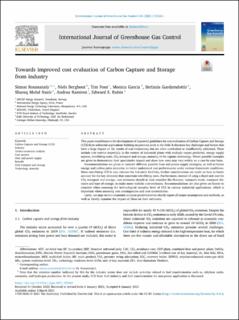| dc.description.abstract | This paper contributes to the development of improved guidelines for cost evaluation of Carbon Capture and Storage (CCS) from industrial applications building on previous work in the field. It discusses key challenges and factors that have a large impact on the results of cost evaluations, but are often overlooked or insufficiently addressed. These include cost metrics (especially in the context of industrial plants with multiple output products), energy supply aspects, retrofitting costs, CO2 transport and storage, maturity of the capture technology. Where possible examples are given to demonstrate their quantitative impact and show how costs may vary widely on a case-by-case basis. Recommendations are given to consider different possible heat and power supply strategies, as well as future energy and carbon price scenarios, to better understand cost performances under various framework conditions. Since retrofitting CCS is very relevant for industrial facilities, further considerations are made on how to better account for the key elements that constitute retrofitting costs. Furthermore, instead of using a fixed unit cost for CO2 transport and storage, cost estimates should at least consider the flowrate, transport mode, transport distance and type of storage, to make more realistic cost estimates. Recommendations are also given on factors to consider when assessing the technological maturity level of CCS in various industrial applications, which is important when assessing cost contingencies and cost uncertainties. Lastly, we urge techno-economic analysis practitioners to clearly report all major assumptions and methods, as well as ideally examine the impact of these on their estimates. | en_US |

